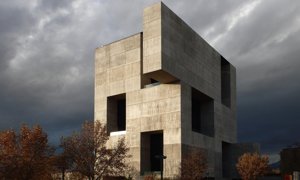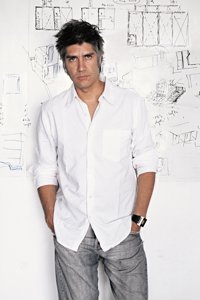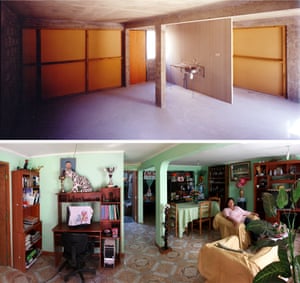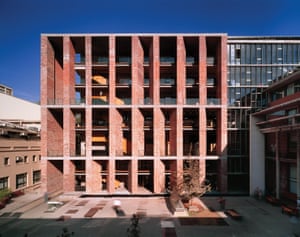January 13, 2016 3:31 pm
An architect known for working with the poor and dispossessed has won his profession’s leading honour
Half a house. It doesn’t seem enough to win a Pritzker Prize. Architecture’s most prestigious honour is usually a reward for a lifetime’s achievement — the liberal peppering of the world’s cities with cultural landmarks. So how has Alejandro Aravena, a 48-year-old Chilean known for working with the poor and the dispossessed, been awarded the profession’s leading honour?
Perhaps it’s because that half a house is half of a very good house indeed.Its brilliance lies in the insight that poor communities could be better, more flexibly and more usefully housed through the provision of a more generous but incomplete structure which they are able to tailor to their own needs.This is in preference to the usual cheap, stigmatising and inflexible mass-produced bungalow-box.
Aravena and his practice Elemental developed this new notion for their Quinta Monroy development, a housing scheme in Iquique in Chile. With a subsidy of just $7,500 per house, they built a courtyard development of tall, elegant dwellings for about 100 families with gaps between them designed to be filled in by their residents as their needs change and their families grow. The result is a terrace of row houses formed by the ad hoc personal touch of the residents.
It was a brilliant way of laying the infrastructure of an architecture, the bare, handsome skeleton of a body which could be overlaid with the muscles developed in real life.
As with all such ideas, once you see it, it is difficult to understand why it has not become ubiquitous. But despite being completed more than a decade ago, Quinta Monroy has not gone mainstream, even though it has become a staple of urbanist and economics lectures and architecture magazines. So it’s as well Aravena’s reputation is bolstered by the kind of work you might more readily expect from a Pritzker Prize winner: impossibly cool villas, sculpturally monumental structures and urban masterplans.
“The time in our office is divided into three,” Aravena tells me over the phone from his Santiago office. “One third mass social housing, one third at a city level and one third where we are architects and our contribution is through form.”
The most impressive of this last type is the massive Innovation Centre at Santiago’s Catholic University. It is a sculptural volume of cast concrete which modulates the internal environment using natural ventilation. But its real significance lies in its appearance, its play of solid and void and its function as a symbol, an architectural signpost.
Aravena has a charming manner and a slick delivery as perfectly tailored for TED talks as it is for international gatherings of wealthy philanthropists. He speaks of economics and inequality but he carefully skirts around the mire of politics and redistribution.
His rise has been meteoric: last year he was appointed as the curator of the 2016 Venice Architecture Biennale, with the Pritzker the twin pole of global architectural credibility. But what is most interesting about him is his belief that architecture can be used to accelerate social change.
“If you start with an idea of architecture as art,” he says, “then buildings may be beautiful — but they risk irrelevance. The challenge is to look at the problems the whole of society is facing: poverty, segregation, violence, insecurity, education, inequality. Sometimes these issues have an industry attached to them — education or health, for instance — but where they do not, that is where architecture can come in.
“The power in architecture,” he continues, getting into what sounds like a well-practised speech, “is in synthesis.”
Isn’t the Pritzker Prize more usually associated with blockbuster cultural projects of architects such as Frank Gehry, Zaha Hadid and Jean Nouvel? “Sometimes,” he replies, “iconic architecture does have a role. It can give form to forces that are in the air. But the big issues require non-spectacular answers.”
When I ask why he thinks Latin American architecture is so good at the moment (in my opinion, far outstripping anything happening in the global north), he says something intriguing — something you rarely hear admitted by architects.
“Scarcity is a great filter against arbitrariness. Sometimes more resources can lead to a scarcity of meaning.”
I ask him to expand.
“The less you have,” he says, “the more you have to explain why you’re doing something. You can now build anything if you have enough money. The question then is ‘So what?’ The best architecture is somewhere between art and survival.”
Where some might see potential disaster in the current explosion of urban populations, Aravena sees hope. “There are 1bn people living below the poverty line in cities. There will be 1bn more. But the city can be a shortcut to equality.
“The challenge for society is that although income increases, so does inequality. How can you address that without redistribution?”
Architecture, he suggests, along with urbanism, is one way. “Public infrastructure, public space, housing, there are infinite opportunities and they are extremely efficient ways of spending public money. Urbanisation,” he declares, “is good news.”
An example of what he’s talking about can be seen in Elemental’s plan for Constitución, the Chilean city which was flattened by a tsunami in 2010. The residents were keen to move back to the sites of their old dwellings, despite the risk. Elemental proposed a forested zone between the sea and the city which would provide protection from the waves and absorption of waters. Combined with striking but simple architectural interventions to remake the public infrastructure of the city — schools, community halls, a theatre and so on — the plan was to make the city’s communal space a source of renewed civic identity. The generosity of the vision and its focus on expansive green public space could provide a paradigm for other damaged city centres from Christchurch to Haiti.
Aravena’s victory reflects, in arguably the best possible way, a degree of guilt about architecture’s elitism. Good-looking, globe-trotting, talented and with a social conscience, Aravena is the architectural establishment’s counter to accusations of detachment from everyday challenges of poverty and inequality, and to the charge that architects are merely fiddling with edges of the world’s greatest problems. His work and his words inspire architects to think about the problems of housing, society, the poor and, perhaps more importantly than anything, to engage with communities and not just each other.
Aravena owes his Pritzker to his offer of hope to a profession fearful of its own lack of engagement. The award is a vaccination against accusations of irrelevance. How could anyone argue with that?
Chilean architect Alejandro Aravena wins 2016 Pritzker prize
Social housing visionary, who engaged residents in designing their own homes, urges architects to address issues of poverty, pollution and segregation
Designs for life: Alejandro Aravena’s best buildings – in pictures
The radical Chilean architect Alejandro Aravena, known for his pioneering social housing projects in Latin America, has been named as the winner of the 2016 Pritzker prize, the highest accolade in architecture.
The 48-year-old, who is also the curator of this year’s Venice ArchitectureBiennale, has made a name for himself over the past decade with projects that reinvent low-cost housing and engage residents in the design of their own homes. It is a refreshing choice for the Pritzker, usually awarded to later-career architects whose portfolios brim with grand cultural monuments.
Announcing the news, Tom Pritzker, whose father founded the prize in 1979, said Aravena’s work “gives economic opportunity to the less privileged, mitigates the effects of natural disasters, reduces energy consumption, and provides welcoming public space … He shows how architecture at its best can improve people’s lives.”
Aravena and his architecture practice, Elemental, first came to international attention in 2004 with a project that redefined the economics of social housing. The challenge was to rehouse 100 families who had been squatting illegally on half a hectare of land in the centre of Iquique in northern Chile. The government’s housing subsidy of US$7,500 (£5,200) per family was nowhere near enough to buy the land and build new homes, particularity on such a valuable site. The usual solution would have been to relocate the residents to the outer suburbs, cutting them off from their families, friends and jobs.
“If there wasn’t the money to build everyone a good house,” said Aravena, on the telephone from his studio in Santiago, “we thought: why not build everyone half a good house – and let them finish the rest themselves.”
Elemental’s terraced houses provided a basic concrete frame, complete with kitchen, bathroom and a roof, allowing families to fill in the gaps, and stamp their own identity on their homes in the process. The result was a far cry from the identikit slabs of nearby social housing blocks. The value of the properties has since increased five-fold, while the model has been rolled out in different forms on other sites in Chile and Mexico involving 2,500 homes.
Aravena is one of a number of young Chilean architects coming to international prominence – along with Serpentine pavilion architect Smiljan Radic, Mathias Klotz and Pezo von Ellrichshausen – a flowering that Aravena partly attributes to scarce resources. “The toughness of the circumstances can work as a useful filter against arbitrariness,” he says. “This environment of scarcity stops you from doing things that are not strictly necessary – whereas abundance can sometimes lead to a culture of doing things just because you can.”
Trained at Universidad Católica de Chile Santiago, Aravena’s first project was a new mathematics faculty for his alma mater, built in 1998. A medical school followed, then the refurbishment of the architecture school, along with a classroom tower and innovation centre, which stands on the Santiago skyline as a startling stack of monolithic concrete blocks.
While Aravena has built an impressive portfolio of buildings, it is the bigger strategic questions that really drive his work, and for which he has been awarded the Pritzker. The judges say he “epitomises the revival of a more socially engaged architect” and gives the profession “a new dimension”.
Elemental is an partnership between a group of architects, a university and the country’s national oil company, Copec – which provided the initial funding. This Robin Hood structure runs throughout Elemental’s work, split three ways between social housing, urban planning and more lucrative commercial contracts. Projects like a new headquarters for pharmaceuticals giant Novartis in Shanghai help to subsidise the more public work, which includes a post-tsunami reconstruction plan for the city of Constitución.
Aravena’s team was charged with devising plans for everything from new housing and public buildings to tsunami mitigation and energy infrastructure in just 100 days. They began by building an “open house” in the city’s main square, a drop-in centre where people could come to discuss and contribute to evolving plans. Dolores Chamorro, a 78-year-old local resident who has lived through a good number of Chilean earth tremors, said their approach was a refreshing change. “I went to every meeting,” she told the Guardian. “It was fantastic having these young architects come in to really make us think about the kind of city we wanted.”
As poster boy for a more critical model of architecture practice, Aravena intends to use his Venice Biennale – titled Reporting from the Front – to raise the volume of debate around global urbanisation. “We will have to house a new city of 1 million people per week over the next 15 years, using resources of just $10,000 per family,” he says.
“One of the biggest mistakes that architects make is that they tend to deal with problems that only interest other architects,” he adds. “The biggest challenge is to engage with the important non-architectural issues – poverty, pollution, congestion, segregation – and apply our specific knowledge. It’s not enough to raise awareness. I want people to leave with more tools. We must share the challenges so we are aware of the coming battles.”
The radical Chilean architect Alejandro Aravena, known for his pioneering social housing projects in Latin America, has been named as the winner of the 2016 Pritzker Architecture Prize, the highest accolade in architecture


















沒有留言:
張貼留言